6. A Description of the Coin Types Minted at Ostia
Although the mint at Ostia was only in operation for approximately five years, a large number of different types of coins were produced. Coin production can be seen to have taken place in two periods namely a) from the inception of the mint in 308/9 to October 312 AD and b) from October 312 to the closure of the mint around May 313 AD. At some stage in the life of the mint gold, silver and bronze coins were all produced, but today all but the bronze are exceedingly rare.
| Table 1: Gold coins of the first period 308/9 to October 312 AD | |||
|
Type
|
Date AD
|
Reverse
|
Obverse
|
|
Double
|
308/9
|
AETERNAE MEMORIAE - Eagle on domed shrine with no columns and the doors open. |
a)
|
|
Aureus
|
308/9
|
VICTORIA AETERNA AVG N - Victory giving a globe to Maxentius (Plate 9) |
b)
|
|
Aureus
|
308/9
|
CONSERVATOR VRBIS SVAE - Roma holding Victory on a globe. |
c)
|
|
Aureus
|
308/9
|
TEMPORVM FELICITAS AVG N - The she-wolf and the twins |
c)
|
|
Aureus
|
310-312
|
MARTI VICTORI COMITI AVG N - Mars with Victory, crowning Maxentius |
c)
|
|
Aureus
|
310-312
|
PAX AETERNA AVG N - Maxentius with a soldier, Roma and Africa |
c)
|
|
Aureus
|
310-312
|
VICTORIA AETERNA AVG N Victory inscribing either VOT/V or VOT/IS/X on a shield |
c)
|
|
Aureus
|
310-312
|
VICTORIA OMNIVM GENTIVM AVG N - Maxentius receiving Victory on a globe from Mars |
c)
|
a) Romulus and DIVO ROMVLO N V BIS CONS
b) Maxentius and MAXENTIVS P F INV AVG
c) Maxentius and MAXENTIVS P F AVG
The authenticity and the weight of the double in the above table is uncertain as the only known example was stolen in 1831. All the coins carried the mintmark POST and the average weight of the aurei was around 5.4g. This was slightly higher than the weight of the aurei produced in the other mints.
In the second period, October 312 to c. May 313 AD, Constantine introduced the gold solidus, which had a reduced average weight of 4.5g. At several mints, multiples of the aureus and the solidus were produced up to multiples of 10 times. At Ostia, solidus 'doubles' and solidus 'halves' were produced weighing 8.35 and 1.9g respectively.
|
Table 2: Gold coins of the second period October 312 to c. May 313 AD
|
|||
|
Type
|
Mintmark
|
Reverse
|
Obverse
|
|
Double
|
POST*
|
PRINCIPI IVVENTIS - Prince holding spear and globe
|
a)
|
|
Solidus
|
POST
|
IOVI CONSERVATORI AVGG - Jupiter on throne holding a thunderbolt
|
b)
|
|
Solidus
|
POST
|
PRINCIPI IVVENTVTIS - Prince holding sphere and globe
|
c)
|
|
Solidus
|
POST
|
SPQR OPTIMO PRINCIPI - Legionary eagle between two vexilla
|
d)
|
|
Solidus
|
POST
|
VICTORIA CONSTANTINI AVG - Victory holding a wreath
|
d)
|
|
Half
|
POST*
|
PRINCIPI IVVENTVTIS - Prince holding sphere and globe
|
e)
|
|
Half
|
POST
|
PRINCIPI IVVENTVTIS - Prince holding sphere and globe
|
f)
|
a) Constantine and IMP CONSTANTINVS P F AVG
b) Licinius and LICINIVS P F AVG
c) Constantine and CONSTANTINVS P F AVG
or Maximinus and MAXIMINVS P F AVG
d) Constantine and CONSTANTINVS P F
e) Licinius and IMP LICINIVS P F AVG
f) Licinius and LICINIVS AVG
Silver coins were only minted in the first period in 308/309 AD, and all bore the legend MAXENTIVS P F AVG. The weight of the coins was c. 3.1g and the mintmarks known are POSTD and MOSTA to MOSTD, those carrying POSTD probably being minted first. It could well be that the mint was set up originally to produce only gold and silver coins and that bronze issues first appeared at the same time that MOSTA to MOSTD was being used on silver coins.
Three types of silver coins are known from the Ostia mint:
a) MARTI PROPAG IMP AVG N - Mars holding a sceptre and facing a female, in between them the she-wolf and the twins. The mintmarks are POSTD, MOSTB, MOSTC or MOSTD.
b) MARTI PROPAGATORI AVG N - Mars giving a Victory on a globe to Maxentius. The mintmark is POSTD.
c) TEMPORVM FELICITAS AVG N - The she-wolf and twins; the mintmarks MOSTA and MOSTB.
Sutherland and Carson in "Roman Imperial Coinage Vol. VI" make mention of a silver coin that was probably cast from a follis carrying the inscriptions IMP C MAXENTIVS P F AVG and VICTORIA AETERNA AVGG, and the mintmark MOSTQ)
The bronze coins (folles) carrying the mintmarks MOSTA to MOSTD and the obverse inscription IMP C MAXENTIVS P F AVG, were probably produced in 308/309 AD. In 301 AD, Diocletian issued the edictum de maximis pretiis rerum venalium (Edict Concerning the Sale Price of Goods) whereby he tried to regulate the maximum prices of a whole range of goods based on the denarius communis. An approximate 'valuation' would suggest that 10 folles were equivalent in value to 50 denarii communes and to 2 denarii argentii, based on the amount of silver they contained. At the turn of the 4th century, the weight of folles produced in the eastern and central mints was within c. 10% of 11g, but by 307 AD the weight had fallen to between 6 and 7g. At Ostia however, the weight of the folles was between 6.0 and 6.75g in the early days of the mint, falling to 5.5 to 6.75g in the period up to October 312 AD. Further reductions in weight occured at all the mints in 312/313 AD, so in the period of Constantine the coins minted at Ostia weighed 3.5 to 4.5g.
In this early period at Ostia (308/309 AD) five different types of coins were minted:
a) AETERNITAS AVG N - Castor and Pollux holding bridled horses, with the mintmarks A,C and D.
b) AETERNITAS AVG N - as above, with the addition of the she-wolf and twins between Castor and Pollux. Mintmarks A to D are known. (Plate 10)
c) AETERNITAS AVG N - the she-wolf and the twins with mintmark D.
d) VICTORIA AETERNA AVG N - Victory advancing left - mintmark C.
e) VICTORIA AETERNA AVG N - Victory advancing right - mintmark C.
f) VOT/X/FEL/ in three lines in wreath - Mintmarks A to D are known.
In late 309 AD the Greek letters incorporated into the mintmarks were changed from A to D to P to Q. One group of coins minted by Maxentius during this later period (up to October 312 AD) was a series of commemoratives to Maximianus (his father), Galerius (his father-in-law), Constantius (his uncle) and Romulus (his son).
|
Table 3: Commemoratives from the period late 309 to October 312 AD
|
|||
|
Type
|
Mintmark
|
Reverse
|
Obverse
|
|
Follis
|
S
|
AETERNA MEMORIA - Eagle on domed hexastyle temple with right door open.
|
a) d)
|
|
Follis
|
PSTQ
|
As above (Plate 11)
|
b) c) h) i)
j) l) m)
|
|
Follis
|
PST
|
As above
|
e)
|
|
Follis
|
ST
|
As above
|
f)
|
|
Follis
|
T
|
As above |
k)
|
|
Follis
|
PSTQ
|
AETERNAE MEMORIAE - As above but no pillars on temple. (Plate 12) |
m)
|
|
Third
|
PSTQ
|
AETERNAE MEMORIAE - As above. |
m)
|
|
Third
|
PSTQ
|
AETERNAE MEMORIAE - As above. |
n)
|
a) DIVO MAXIMIANO SEN AVG
b) DIVO MAXIMIANO PATRI MAXENTIVS AVG
c) IMP MAXENTIVS DIVO MAXIMIANO PATRI
d) MAXENTIVS AVG DIVO MAXIMIANO PATRI
e) DIVO CONSTANTIO COGN MAXENTIVS AVG
f) IMP MAXENTIVS DIVO CONSTANTIO COGN
g) DIVO CONSTANTIO ADFINI MAXENTIVS AVG
h) IMP MAXENTIVS DIVO CONSTANTIO ADFINI
i) DIVO MAXIMIANO SOCERO MAXENTIVS AVG
j) IMP MAXENTIVS DIVO MAXIMIANO SOCERO
k) DIVO ROMVLO N V FILIO MAXENTIVS AVG
l) IMP MAXENTIVS DIVO ROMVLO N V FILIO
m) DIVO ROMVLO N V BIS CONS
n) DIVO ROMVLO N V BIS C
All the remaining bronze coins produced in this period up to October 312 AD carry the obverse inscription IMP MAXENTIVS P F AVG, with the exception of the rare type VICTORIA AETERNA AVG N with the obverse legend VIRTVS MAXENTI AVG. Most are folles weighing 5.5 to 6.75g. Halves have the inscription MAXENTIVS P F AVG weighing 2.75 to 3.25g. Third folles have the inscription MAXENTIVS P F AVG weighing 1.4 to 1.8 grams.
| Table 4: Folles produced up to October 312 AD | |||
|
Type
|
Mintmark
|
Reverse
|
|
|
Follis
|
Q
|
ADLOCVTIO AVG N - Maxentius addressing troops | |
|
Follis
|
PSTQ
|
AETERNITAS AVG N - Castor and Pollux | |
|
Follis
|
STQ
|
AETERNITAS AVG N - Wolf and twins facing right. | |
|
Follis
|
PSTQ
|
AETERNITAS AVG N - Wolf and twins facing left. (Plate 13) | |
|
Follis
|
ST
|
AETERNITAS AVG N - Fides with standard in each hand. | |
|
Follis
|
PSTQ
|
FIDES MILITVM AVG N - As above (Plate 15) | |
|
Follis
|
T
|
MARTI COMITI AVG N - Mars with branch, shield and spear | |
|
Follis
|
T
|
MARTI COMITI AVG N - Mars with spear and trophy. | |
|
Follis
|
P
|
MARTI COMITI AVG N - As above, also dragging captive | |
|
Follis
|
T
|
MARTI COMITI AVG N - Mars with spear and trophy. holding shield | |
|
Follis
|
P
|
MARTI VICTORI AVG N - Maxentius standing right, leaning on cuirass receiving globe | |
|
Follis
|
STQ
|
SAECVLI FELIC AVG N - Wolf and twins | |
|
Follis
|
PSTQ
|
SAECVLI FELICITAS AVG N - Wolf and twins. (Plate 14) | |
|
Follis
|
PTQ
|
VICTORIA AETERNA AVG N - Victory advancing left. (See Plate 16) | |
|
Follis
|
PSTQ
|
VICTORIA AETERNA AVG N - Victory advancing right. | |
|
Follis
|
T
|
VICTORIA AETERNA AVG N - Victory advancing right, captive standing left | |
|
Follis
|
T
|
VICTOR OMNIVM GENT AVG N - Maxentius receiving Victory from Mars. | |
|
Follis
|
Q
|
VICTOR OMNIVM GENTIVM AVG N - Maxentius receiving Victory from Mars. | |
|
Follis
|
T
|
VIRTVS AVG N - Maxentius on horseback plunging spear over two of the enemy. | |
|
Follis
|
Q
|
VOT OPTATA ROMAE FEL - Victory inscribing on a shield. | |
|
Half
|
PSTQ
|
VICTORIA AETERNA AVG N - Victory inscribing VOT/X on shield in two lines. (Plate 17) | |
|
Half
|
PSTQ
|
VICTORIA AETERNA AVG N - Victory inscribing VOT/XX/FEL in three lines. (Plate 18) | |
|
Half
|
S
|
SECVLO FELICI AVG N - Victories attaching shield to palm tree. VOT/XX/FEL in three lines | |
|
Half
|
Q
|
SECVLO FELICI AVG N - Victories attaching shield to palm tree. VOT/XX/FEL in three lines | |
|
Third
|
-
|
VOT/QQ/MVL/X in four lines in wreath. | |
|
Third
|
-
|
VOT/QQ/MVL/X/FEL in five lines in wreath. | |
|
Third
|
-
|
VOT/QQ/MVL/XX in four lines in wreath. | |
|
Third
|
-
|
VOT/QQ/MVL/XX/FEL in five lines in wreath. | |
From October 312 AD through to the closure of the mint in 313 AD, folles continued to be minted weighing between 3.5 and 5g and more. The mintmarks used were MOSTP to MOSTQ and the obverse inscriptions on the coins read either IMP C CONSTANTINVS P F AVG, IMP MAXIMINVS P F AVG or IMP LICINIVS P F AVG. One specimen for Licinius has been recorded with the obverse legend IMP C LICINIVS P F AVG.
Four major issues were minted carrying the obverse images of either Constantine, Maximinus or Licinius:
1) GENIO POP ROM - Genius with modius on head, holding patera and cornucopiae.
2) SOL INVICTO COMITI - Sol holding globe close to body.
3) SOL INVICTO COMITI - Sol holding globe up.
4) S P Q R OPTIMO PRINCIPI - Legionary eagle between two vexilla.
With the reverse image, the head is always facing right. The figure can be either A) laureate and draped, B) laureate wearing a cuirass, C) laureate and draped with a cuirass or D) laureate and draped with a cuirass, but seen from the rear (see the following four tables).
|
Table 5: GENIO
POP ROM
|
||||
|
Obverse image
|
Mintmark
|
Obverse image
|
Mintmark
|
|
|
Constantine
- A)
|
PQ
|
Maximinus -
C)
|
T
|
|
|
Constantine
- B)
|
PSTQ
|
Maximinus -
D)
|
T
|
|
|
Constantine
- C)
|
PSTQ
|
Licinius - B)
|
PQ
|
|
|
Constantine
- D)
|
PQ
|
Licinius - C)
|
Q
|
|
|
Maximinus -
B)
|
T (Plate 19)
|
|
|
|
|
Table 6: SOLI
INVICTO COMITI - (Globe close to body)
|
||||
|
Obverse image
|
Mintmark
|
Obverse image
|
Mintmark
|
|
|
Constantine
- B)
|
PSTQ (Plate
20)
|
Maximinus -
C)
|
T
|
|
|
Constantine
- C)
|
PSTQ
|
Maximinus -
D)
|
T
|
|
|
Constantine
- D)
|
PSTQ
|
Licinius - B)
|
PSQ
|
|
|
Maximinus -
B)
|
STQ
|
Licinius - C)
|
TQ
|
|
|
Table 7: SOL
INVICTO COMITI - (Globe held up)
|
||||
|
Obverse image
|
Mintmark
|
Obverse image
|
Mintmark
|
|
|
Constantine
- B)
|
PST
|
Maximinus -
C)
|
ST
|
|
|
Constantine
- C)
|
PTQ
|
Licinius - B)
|
PQ
|
|
|
Constantine
- D)
|
PQ
|
Licinius - C)
|
Q
|
|
|
Maximinus -
B)
|
PT
|
|
|
|
|
Table 8: SPQR
OPTIMO PRINCIPI
|
||||
|
Obverse image
|
Mintmark
|
Obverse image
|
Mintmark
|
|
|
Constantine
- B)
|
PSTQ
|
Maximinus -
C)
|
T
|
|
|
Constantine
- C)
|
PSTQ
|
Maximinus -
D)
|
T
|
|
|
Constantine
- D)
|
PSQ
|
Licinius - B)
|
PSQ
|
|
|
Maximinus -
B)
|
ST
|
Licinius - C)
|
Q
|
|
Five other types of folles were produced in this late phase of the mint bearing Constantine on the obverse. One coin type carried exclusively the image of Maximinus on the obverse.
| Table 9: Other folles bearing the image of Constantine or Maximinus | |||
|
Obverse
|
Reverse
|
Mintmark
|
|
|
Constantine - B)
|
HERCVLI VICTORI - Hercules holding apples and lion's skin. |
S
|
|
|
Constantine - B C)
|
HERCVLI VICTORI - Hercules standing left, right holding Victory on globe and lion's skin, left leaning on club. |
P
|
|
|
Constantine - C)
|
MARTI CONSERVATORI - Mars facing right holding spear and shield. |
T
|
|
|
Constantine - C)
|
MARTI CONSERVATORI - Mars facing left holding branch and shield. |
T
|
|
|
Constantine - C)
|
SOLI INVICTO COMITI - Sol facing left, holding globe & trampling on enemy. |
P
|
|
|
Constantine - B)
|
VICTORIA AET AVGGG NNN - Victory inscribing VOT/X in two lines on a shield. |
P
|
|
|
Constantine - B)
|
VICTORIA AET AVGGG NNN - Constantine standing in military dress receiving globe. |
T
|
|
|
Maximinus - B)
|
HERCVLI VICTORI - Hercules standing left, right holding Victory on globe and lion's skin, left leaning on club. |
P
|
|
|
Maximinus - C)
|
SOLI INVICTO COMITI - Sol facing left, holding globe and trampling on enemy. |
T
|
|
|
Maximinus - B)
|
RESTITVTOR ROMAE - Roma giving globe to emperor, leaning on a sceptre. |
S
|
|
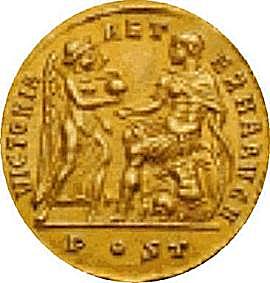 |
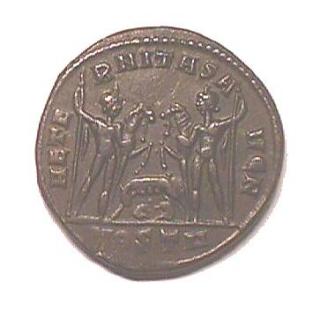 |
| Plate 9: Victory giving a globe to a seated Maxentius in military dress. |
Plate 10: Castor and Pollux holding bridled horses with she-wolf and twins in between. |
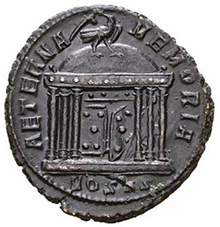 |
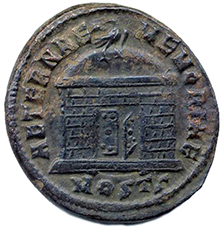 |
Plate 11: An eagle with outspread wings on a domed hexastyle temple. |
Plate 12: An eagle with outspread wings on a temple without columns. |
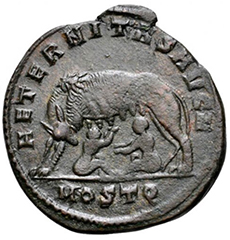 |
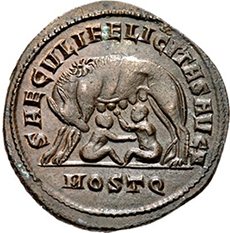 |
Plate 13: The twins with AETERNITAS AVG N legend. | Plate 14: The twins with the left facing she-wolf. |
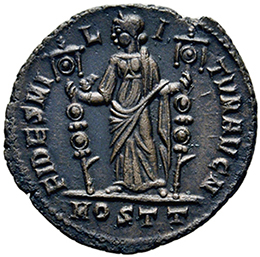 |
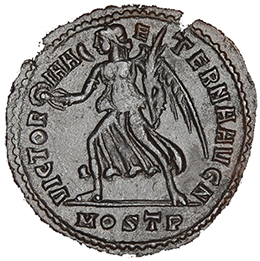 |
Plate 15: Fides holding a standard in both hands. |
Plate 16: Victory advancing left, holding a wreath and a palm leaf. |
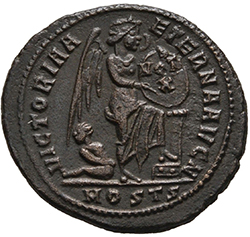 |
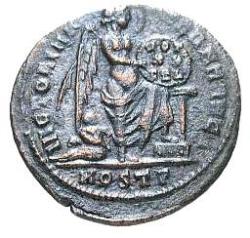 |
Plate 17: Victory inscribing VOT/X onto a shield in two lines. |
Plate 18: Victory inscribing VOT/XX/FEL onto a shield on three lines. |
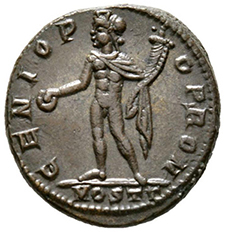 |
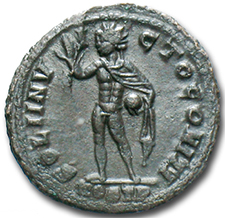 |
Plate 19: Genius with modius on head, holding patera and cornucopiae. |
Plate 20: Sol with right hand raised, holding a globe close to the body. |
Many other reverse types were produced. A list can be found in Appendix 1 in the summary of the article written by Jules Maurice in 1908.
When one takes into account the inscriptions on the reverse faces, the picture becomes even more complicated. Twenty-six inscriptions are known, but from different dies. The inscriptions can be seen to be made up of different lettering and, more obviously, different 'breaks' in the text. Plates 21 and 22 show two such differences in breaks in the text (AET / ERNITAS A / VGN is also known).
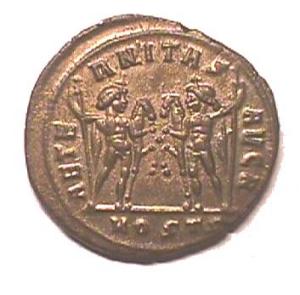 |
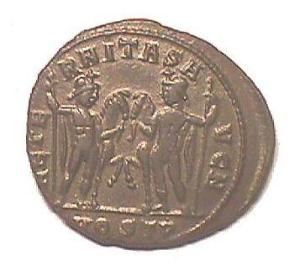 |
| Plate 21: AETE / RNITAS / AVGN | Plate 22: AETE / RNITASA / VGN |
On the obverse faces of the coins appear the images of Maxentius, Maximinus, Romulus, Licinius, Galerius and Constantine I. On Roman coins, portraits are most frequently shown facing to the right of the coin. Left facing is standard in some periods, and at times, heads can be found facing in either direction. The following terms are used to describe the portrait:
Bare headed - showing nothing lower than the neck and no head gear.
Laureate - wearing a laurel wreath, tied at the back with ribbons that hang down behind.
Bust - if anything below the neck is shown, e.g. shoulders, then the result is a bust.
Cuirassed - shows evidence of the wearing of military armour.
Veiled - usually describes the portrait of a deceased person.
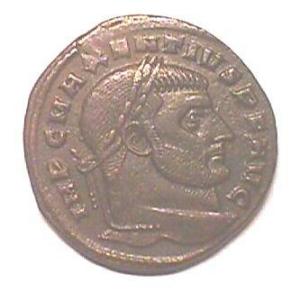 |
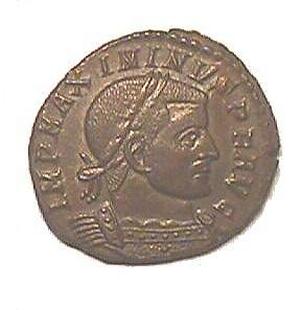 |
| Plate 23: A typical bare-headed, right facing portrait of the head of Maxentius. |
Plate 24: Laureate head with cuirassed shoulders on a reduced follis of Maximinus. |
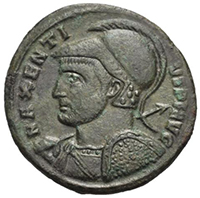 |
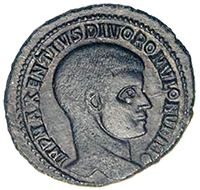 |
| Plate 25: Maxentius, helmeted, wearing a cuirass and carrying a spear and shield. |
Plate 26: Bare headed Romulus facing right. |
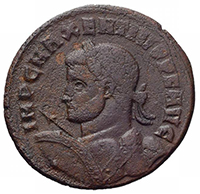 |
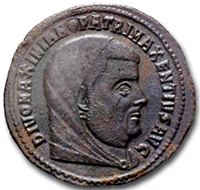 |
| Plate 27: Maxentius, laureate, holding spear and shield. |
Plate 28: Maximianus wearing a veil. |
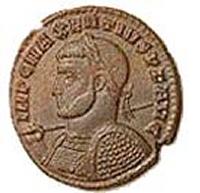 |
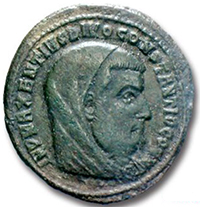 |
| Plate 29: Maxentius, laureate, with a cuirass and holding a spear and shield. |
Plate 30: Constantius veiled and right facing. |
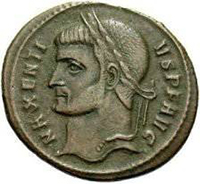 |
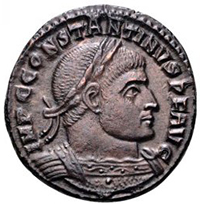 |
| Plate 31: Laureate Maxentius facing left. |
Plate 32: Constantine, laureate and wearing a cuirass. |
A list of all the obverse and reverse inscriptions can be found in Appendix 1.